Making Room for a River
How one town restored a river to protect its way of life.
Rivers shaped California’s Central Valley, but when people started shaping rivers the trouble started. This is the story of how the community of Hamilton City protected itself from flooding by bringing natural features back to the Sacramento River.
The Sacramento River
Rivers in California’s Central Valley like to go their own way: they expand, contract, meander and regenerate soil in the process. The historic movement of rivers is what made Central Valley soil so fertile. Naturally flowing rivers recharge and save water for people and nature, providing habitat for many species including four distinct runs of chinook salmon.
Before the early 20th century, the Sacramento River had one of the biggest salmon runs in North America and the course of the river changed constantly as it lazily meandered from east to west through the millenia. But a new wave of people and agriculture changed all that beginning with the Gold Rush.

The Central Valley We Know Today
As agriculture, towns, and industry expanded in the Central Valley, rivers became a nuisance that needed to be controlled. People built infrastructure that couldn’t move, like farms and towns. But the Sacramento River kept being itself, flooding periodically and changing course. So people put up levees to hold the river back and lined those levees with rock, disconnecting floodplain habitat for fish and wildlife.
But the Sacramento couldn’t be contained and the levees resulted in flooding downriver, destroying habitat and constricting the river so that people had to build higher and higher levees to keep it contained.
WE CAN STRIKE A BETTER BALANCE FOR PEOPLE AND NATURE


The problem: Around the community of Hamilton City, old infrastructure prevented the Sacramento River from being the river it once was. In the early 20th century, a levee was hastily built to protect a new sugar factory around which the community of Hamilton City grew. This levee resulted in serious consequences for people and nature.
Consequences for nature: Depletion of groundwater, loss of riverside habitat harming songbirds and salmon, soil degradation, and even contamination from raw sewage.
Consequences for people: The community grew assuming it was protected. But as more people came, more people found themselves at risk of being flooded.
Hamilton City Heroes
Lee Ann and Jose Puente loved their home and knew they had to fight for a solution to stop the flooding. Together with other community members, they searched for a solution that could work with the river and not against it. And that search started in the 1970s.
Their work came from a place of resilience and a love of their hometown. They enlisted lawyers and paid legal fees by selling tamales, tacos and burritos at “Levee Festivals.”
For a project of this size, Lee Ann and Jose knew the town needed big guns, so they went to the U.S. Army Corps of Engineers and the State of California but got rebuffed. At the time the cost of constructing a new levee was greater than the potential value of reduced flood damages.
But in 2000, the Army Corps of Engineers started valuing ecosystems, and suddenly the equation changed for Hamilton City. A better levee system was now a possibility.
The town asked TNC to partner with them, not only in designing the project, but in getting it funded by the US government.
And over the course of 20 years, we worked together to create a new levee system that would minimize the risks and maximize the benefits. In a grand partnership that included the community, TNC and the Army Corps of Engineers, the California Department of Water Resources, the California Wildlife Conservation Board, and Glenn County, we designed, funded and implemented a project that allowed the Sacramento River to "breathe" near Hamilton City, creating new natural areas while simultaneously improving the community's ability to withstand flooding.


The problem of flooding is no longer getting passed downstream with faster flowing water and a vulnerable wastewater treatment plant. But it’s not just people who benefit. The new levee system, now set back from the river’s edge, involves reconnecting a portion of the historic floodplain that was cutoff by a levee built in 1906, and restoring critical native riparian habitats that increases habitat for native species and help regenerate soils, elevating the area’s overall ecological health.
Benefits of the New Levee System:
- More Habitat
- Safer Community
- Saving Money
At the end of 2021, the project’s partners brought the flood protection portion of the project across the finish line. The riparian habitat restoration continues and will be completed in 2025.
This is how the river looks today:



We have spent billions of dollars over the last century taming our rivers and we will be spending billions more in the decades to come. But Hamilton City is proof that when we work with nature we can make infrastructure that serves people, creates habitat and lasts a whole lot longer.
Nature is the Solution: Hamilton City is inspiring a new generation of environmental design! This project can be a model for how California and other states think about climate resilience. Win-wins like the Hamilton City Project are too good not to be repeated.
Make a Difference in California
Together, we can achieve transformative change on a scale that’s attainable—for California, and for the world.
You may also like

California History
We're celebrating 60 years of conservation in the Golden State.

California Donor Stories
Meet some of the California donors who are helping us find sustainable solutions to the biggest challenges facing California's natural resources.

Staff Stories
Explore with our staff and scientists and get a firsthand look at what it takes to get conservation done on a day-to-day basis.

